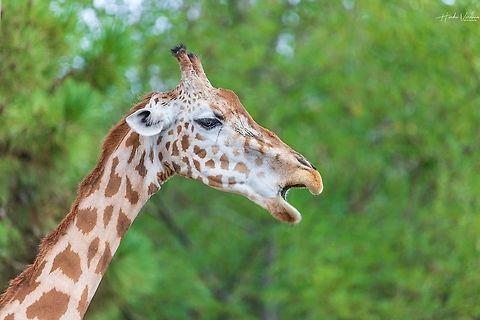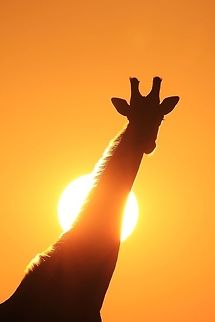
Appearance
A fully grown giraffe is typically 5–6 m tall, with males taller than females. The average weight is 1,200 kg for an adult male and 830 kg for an adult female.The coat is made up of brownish blotches or patches separated by light hair. Each individual giraffe has a unique coat pattern. The coat pattern serves as camouflage, allowing it to blend in with the light and shade combinations of savanna woodlands. In particular, the patches may also serve as thermal windows, being sites for complex blood vessel systems and large sweat glands.
Giraffes have thick skin which allows them to run through thorn bush without much injury. Their fur may serve as a chemical defence, as it is full of parasite repellents that give the animal a characteristic scent. There are at least eleven main aromatic chemicals in the fur, although indole and 3-methylindole are responsible for most of the smell. Because the males have a stronger odour than the females, it is suspected that it also has a sexual function. Along the animal's neck is a brown mane made of short, stiff hairs. The tail has a tuft of long, dark hair at the end and is used to swat flies away.
The giraffe has fairly large eyes, which are located at both sides of the head and bulge outward, providing the animal good all-round vision from its great height. Giraffes are capable of seeing in color and their senses of hearing and olfaction are also advanced.
The nostrils have muscular openings, which allow the animal to open and close them. This may serve to protect against sandstorms and the ants that inhabit the trees it feeds on. The giraffe's tongue is about 50 cm long and prehensile. It is purplish-black in color, perhaps to protect against sunburn, and is useful to gripping branches and stripping leaves as well as for grooming and cleaning the animal's nose.
The upper lip of the giraffe is also prehensile and can grasp foliage. The lips, tongue and inside of the mouth are covered in papillae to protect against thorns.
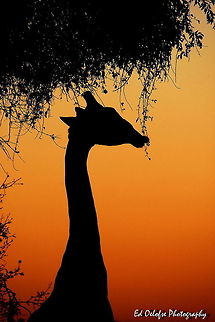
Naming
The name ''giraffe'' has its earliest known origins in the Arabic word الزرافة ''al-zirāfah'', perhaps from an African name. There were several Middle Eastern spellings such as ''jarraf'', ''ziraph'', and ''gerfauntz''.The Italian form ''giraffa'' arose in the 1590s from Arabic. It appears in English from the 16th century through the French ''girafe''. The species name ''camelopardalis'' is a Latin word, a romanization of the Greek καμηλοπάρδαλις, from κάμηλος , "camel", + πάρδαλις , "leopard". ''Kameelperd'' is also the name for the species in Afrikaans.
Among native Africans, the giraffe is known by many names, including ''Ekorii'', ''Kanyiet'', ''Nduida'', ''Tiga'', ''Ndwiya'', ''Nudululu'', ''Ntegha'', ''Ondere'', ''Etiika' , ''Kuri' , ''Oloodo-kirragata'' or ''Olchangito-oodo'', ''Lenywa'', ''Hori' , ''Lment'', ''Geri'' and ''Twiga''.
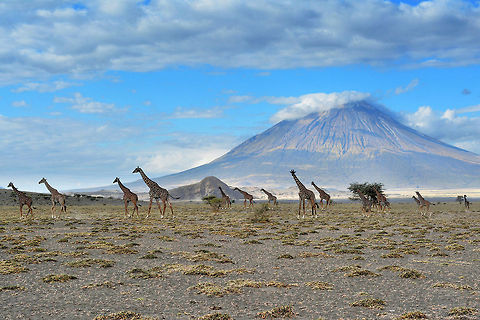
Distribution
The Northern giraffes live in the savannahs, shrublands and woodlands. After local extinctions in various places, the Northern giraffes are the least numerous species and the most endangered.In East Africa, they are mostly found in Kenya and southwestern Ethiopia, though rarely in northeastern Democratic Republic of the Congo and South Sudan. There are about 2,000 in the Central African Republic, Chad and Cameroon of Central Africa.
Once widespread in West Africa, a few hundreds of Northern giraffes are confined at the Dosso Reserve of Kouré, Niger. They are common in both in and outside of protected areas.
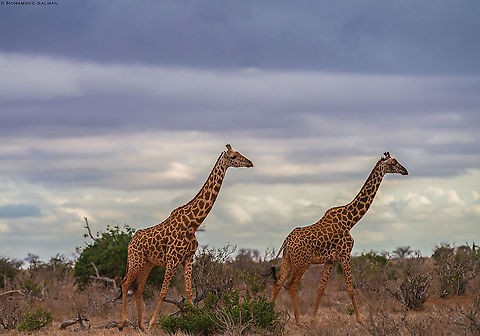
Status
All giraffes are considered Vulnerable to extinction by the IUCN. In 2016, around 97,000 individuals from all subspecies were present in the wild. There are currently 5,195 northern giraffes.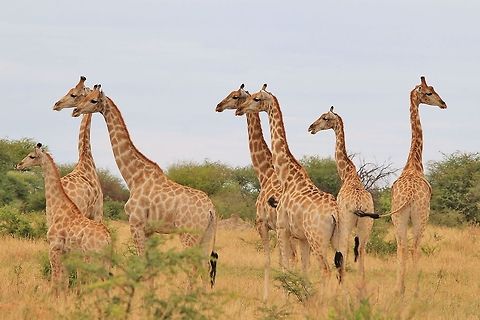
Behavior
While giraffes are usually found in groups, the composition of these groups is more fluid than in other social ungulates. They have few strong social bonds, and aggregations usually disband every few hours, although calving groups can last weeks or months.Giraffe groups usually consist of just a few members, although 40 or more occur on occasion. Adult males tend to be solitary. Female giraffes associate in groups of roughly a dozen, occasionally including a few younger males.
Calves and subadults are rarely alone. Subadult males, in particular, are very social and engage in playfights. Giraffe groups with young tend to feed in more open areas, presumably to make it easier to detect predators, although it may reduce their feeding efficiency. Giraffes are not territorial, but they have home ranges. Male giraffes occasionally wander far from areas that they normally frequent.
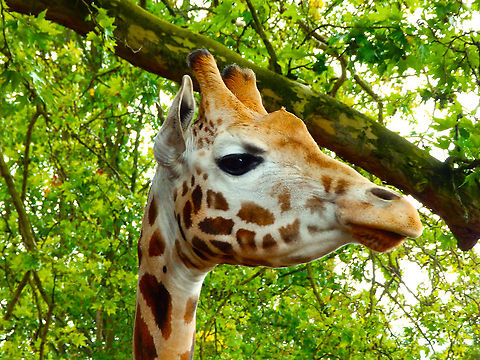
Reproduction
Reproduction is broadly polygamous: a few older males impregnate all the fertile females. Male giraffes assess female fertility by tasting the female's urine in order to detect estrus, in a multi-step process known as the Flehmen response.Once an estrous female is detected, the male will attempt to court her. Males prefer younger females, possibly because the latter are more fertile, while females prefer older, more dominant males.
During courtship, dominant males will displace subordinate ones from the presence of the females by staring and walking towards them. The female prolongs the courtship process for as long as possible, so only the most dominant male remains to mate with.
During copulation, the male stands on its hind legs with its head sticking straight up and its front legs resting loosely on the female's sides.
Although generally quiet and non-vocal, giraffes have been heard to communicate with various sounds. During courtship, males emit loud coughs. Females call their young by bellowing. Calves bleat, moo or make mewing sounds. Giraffes also snort, hiss, moan, make flute-like sounds, and communicate over long distances using infrasound.

Food
Giraffes usually inhabit savannas, grasslands and open woodlands. They prefer ''Acacia'', ''Commiphora'', ''Combretum'' and open ''Terminalia'' woodlands and are not as common in denser ''Brachystegia'' woodland.Giraffes browse on the twigs of trees, preferring trees of genera ''Acacia'', ''Commiphora'' and ''Terminalia''. They also feed on shrubs, grass and fruit. A giraffe eats 65 lb of leaves and twigs daily, but can survive on just 15 lb.
During the wet season, food is abundant and giraffes disperse widely, but during the dry season they need to congregate around evergreen trees and bushes. As a ruminant, it first chews its food, then swallows it for processing and then visibly passes the half-digested cud up the neck and back into the mouth to chew again. This process is usually repeated several times for each mouthful.
The giraffe requires less food than many other herbivores, because the foliage it eats has more concentrated nutrients and it has a more efficient digestive system. When feeding, it is common for a giraffe to produce excess saliva.
While the giraffe can survive without water, it will drink at intervals of three days or less when it has access. Giraffes can also get water from dew-covered green leaves.
Giraffes have a great effect on the trees that they feed on, delaying the growth of young trees for an extra year and forming "waistlines" around trees that are too tall.
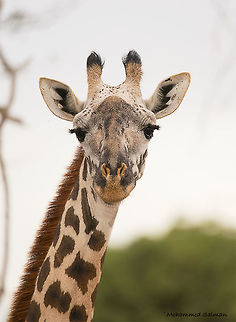
Predators
Healthy adult giraffes are almost invulnerable to predation due to their size; a giraffe can defend itself with powerful kicks, which can kill a predator when well-placed. Calves, on the other hand, are preyed on by lions, leopards, spotted hyenas and wild dogs.A quarter to a half of giraffe calves reach adulthood. Maximum lifespan is around 25 years in the wild. Lions are capable of killing adult giraffes if they can make them fall over. In Kruger National Park, giraffes are commonly preyed on by lions. Nile crocodiles can also be a threat to giraffes when they bend down to drink.
Some parasites feed on giraffes. They are often hosts for ticks, especially in the area around the genitals, which has thinner skin than other areas. Tick species that commonly feed on giraffes are those of genera ''Hyalomma'', ''Amblyomma'' and ''Rhipicephalus''.
Giraffes may rely on red-billed and yellow-billed oxpeckers to clean them of ticks and alert them to danger. Giraffes host numerous species of internal parasite and are susceptible to various diseases. They were victims of the viral illness rinderpest.
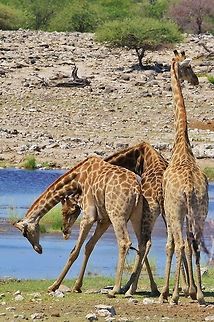
Evolution
The giraffe is one of only two living species of the family Giraffidae, the other being the okapi. The family was once much more extensive, with over 10 fossil genera described. The ancestors of modern giraffids probably evolved 8 million years ago in south-central Europe during the Miocene epoch.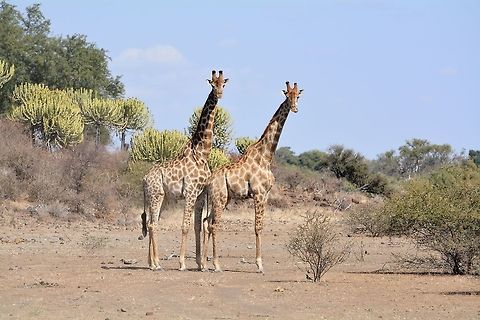
Cultural
Humans have interacted with giraffes for millennia. The Bushmen of southern Africa have medicine dances named after some animals; the giraffe dance is performed to cure head ailments.Giraffes were subjects of art throughout the African continent, including those of the Kiffian, Egyptians and Meroë Nubians.
References:
Some text fragments are auto parsed from Wikipedia.
